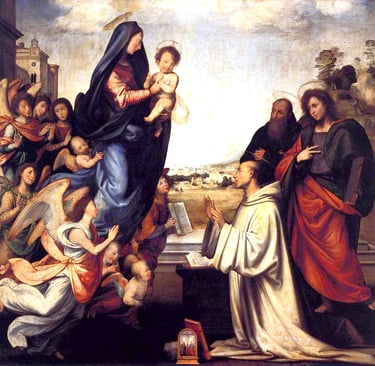
VISIO DIVINA
Art can speak deeply to our hearts about the deeper meaning of our lives. We can dive into the beautiful and be rewarded with the pearl of great truth.
FOR THIS ISSUE: N.1/Prayer
Fra Bartolomeo:
Apparition of the Virgin Mary to St. Bernard


Baccio della Porta (Fra Bartolomeo) was born in Prato in 1472 and became a renowned painter in Cosimo Rosselli's Florentine school. Inspired by the teachings of Savonarola, who was preaching at San Marco in Florence at the time, Baccio abandoned his career and possessions in 1500 to become a Dominican friar. Having become Friar Bartolomeo, he thought he would never pick up a paintbrush again. However, his superior believed that the Gospel should be both preached and illustrated. In 1504, he asked Bartolomeo to take charge of the monastery workshop. That year, he began working on The Vision of St. Bernard for the family chapel of Bernardo Bianco in the Badia Fiorentina, which he finished in 1507.






The subdued colors of this oil painting lend the scene a special, mystical aura. This effect is enhanced by the use of chiaroscuro and the figures' extreme composure, which invite contemplation and prayer.
St. Bernard is depicted kneeling and ready to receive Baby Jesus from the Virgin Mary. The Virgin, majestically carried from left to right on a flotilla of angels, halts before St. Bernard but does not look at him. She is absorbed in contemplation of the Child, who gently turns to the saint and raises his little fingers in blessing.
Thus, Fra Bartolomeo captured the essence of Bernardine theology in the movement of the three faces: the contemplation of the Incarnate Word, who ‘abbreviated’ himself by taking on flesh so that we might fix our eyes on him without being annihilated by his light. The sculptural elegance of the bodies and drapery, which impressed and influenced Raphael, conveys respect for the human body, created in God’s image and destined to become the temple of the Word.
St. John the Evangelist and St. Benedict appear to be standing behind St. Bernard, as if approving of his wisdom, theology, and monastic reform. They seem to say, echoing Caesarius of Heisterbach, “The Gospel had come to life again" (Diagolus miraculorum I.6).
Yes, the Gospel has come to life again, not only in Saint Bernard, but also in St. Francis, receiving the stigmata, as seen in the background, almost behind the head of John the Evangelist. The Gospel has also come to life in St. Dominic, who is depicted meeting St. Francis further up. Fra Bartolomeo seems to tell us that the Incarnation, about which St. Bernard wrote so well as to receive the blessing of the Divine Child, is not an event of the past. Rather, it is present in history, from St. John the Apostle to St. Benedict, St. Bernard, St. Francis, and St. Dominic. It should become the content of prayer and gratitude throughout the centuries.
Was Fra Bartolomeo's painting The Apparition of the Virgin inspired by San Bernard’s youthful vision of the Nativity of the Lord?
Was Fra Bartolomeo familiar with William of St. Thierry's writings on this event? “Then it happened that the child Jesus revealed himself in his Holy Nativity to the little boy, awakening in him the beginnings of divine contemplation and increasing his tender faith. Jesus appeared to him like the spouse coming forth from his chamber” (VP II.4).
Although we cannot know for certain, St. Bernard in Bartolomeo's painting seems to embody that memory.
We, too, are invited to dwell on the memory of the Incarnation—that "Dulcis Memoria" that is the focus of our constant prayers.
MO. GIOVANNA GARBELLI, MATUTUM

